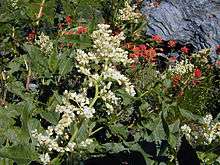Koenigia phytolaccifolia
Koenigia phytolaccifolia (synonym Aconogonon phytolaccifolium) is a species of flowering plant in the knotweed family,[1] known by the common name poke knotweed.
| Koenigia phytolaccifolia | |
|---|---|
 | |
| Scientific classification | |
| Kingdom: | Plantae |
| Clade: | Tracheophytes |
| Clade: | Angiosperms |
| Clade: | Eudicots |
| Order: | Caryophyllales |
| Family: | Polygonaceae |
| Genus: | Koenigia |
| Species: | K. phytolaccifolia |
| Binomial name | |
| Koenigia phytolaccifolia | |
| Synonyms[1] | |
| |
Description
Koenigia phytolaccifolia is a perennial herb up to 200 cm (79 in) tall. The lance-shaped or pointed oval leaves are 10 to 20 centimeters long and borne on petioles. The leaves have large stipules which form reddish ochrea up to 3 centimetres (1.2 inches) long. The inflorescence is a long array of branching cluster of many white or greenish flowers. Each flower is about 4 millimetres (0.16 inches) wide and has tiny protruding stamens tipped with yellow or pink anthers.[2]
Distribution
Koenigia phytolaccifolia is native to the western United States: California, Oregon, Washington, Nevada, Idaho, and Montana.[3][4][5]
References
- "Koenigia phytolaccifolia (Meisn. ex Small) T.M.Schust. & Reveal", Plants of the World Online, Royal Botanic Gardens, Kew, retrieved 2019-02-24
- Flora of North America, Aconogonon phytolaccifolium (Meisner ex Small) Small 1917 Poke knotweed
- Biota of North America Program 2014 county distribution map
- Calflora taxon report, University of California, Aconogonon phytolaccifolium (Meisn. ex Small) Small ex Rydb., Davis knotweed
- Turner Photographics, Wildflowers of the Pacific Northwest, Polygonum phytolaccifolium Alpine Knotweed photos, description, partial distribution map